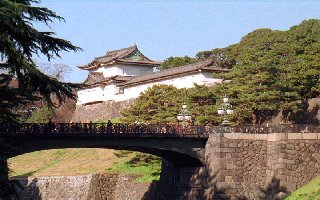
|
- Edo Castle, also called Chiyoda Castle was firstly built by Ota Dokan in 1457. It had begun to develop really after a settlement of Tokugawa Ieyasu in the region in 1590 and completed in Iemitsu's era. After a collapse of Tokugawa Shogunate in 1868, the castle has been confiscated by the new government and become the imperial palace.
- Reflecting calmly its image on a moat of the Imperial Palace, Fushimi Tower's name comes from the fact that it has been transferred from Fushimi Castle in Kyoto. Though the main donjon having burned out during the great fire of Meireki Era in 1657, the palace keeps still many towers and gates from the old time and shows an ambiance of Edo Period.
- Nijubasi (Double Bridge) is a iron bridge that you will encounter just behind the main gate, after passed through a stone bridge, if you come from a square before the Imperial Palace. Its name stems from the fact that a preexisting wooden bridge of Edo Period had two-staged girders because of a deep moat and the technical difficulty.
- On January 2nd of each year, the Japanese Emperor meets his people in the palace in order to celebrate a new year. Because the public are allowed to enter the palace passing through Nijubashi Bridge only in this day and in the birth day of the Emperor on 23 December, it is very crowded. Otherwise, you need to ask for a special permission to enter.
|

 Japanese display
Japanese display
 French display
French display

